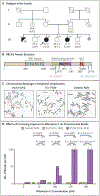Essential Role of BRCA2 in Ovarian Development and Function
- PMID: 30207912
- PMCID: PMC6230262
- DOI: 10.1056/NEJMoa1800024
Essential Role of BRCA2 in Ovarian Development and Function
Abstract
The causes of ovarian dysgenesis remain incompletely understood. Two sisters with XX ovarian dysgenesis carried compound heterozygous truncating mutations in the BRCA2 gene that led to reduced BRCA2 protein levels and an impaired response to DNA damage, which resulted in chromosomal breakage and the failure of RAD51 to be recruited to double-stranded DNA breaks. The sisters also had microcephaly, and one sister was in long-term remission from leukemia, which had been diagnosed when she was 5 years old. Drosophila mutants that were null for an orthologue of BRCA2 were sterile, and gonadal dysgenesis was present in both sexes. These results revealed a new role for BRCA2 and highlight the importance to ovarian development of genes that are critical for recombination during meiosis. (Funded by the Israel Science Foundation and others.).
Figures



Comment in
-
BRCA2 in Ovarian Development and Function.N Engl J Med. 2019 Mar 14;380(11):1086. doi: 10.1056/NEJMc1813800. N Engl J Med. 2019. PMID: 30865812 No abstract available.
-
BRCA2 in Ovarian Development and Function.N Engl J Med. 2019 Mar 14;380(11):1086-1087. doi: 10.1056/NEJMc1813800. N Engl J Med. 2019. PMID: 30865813 No abstract available.
Similar articles
-
Lower level of BRCA2 protein in heterozygous mutation carriers is correlated with an increase in DNA double strand breaks and an impaired DSB repair.Cancer Lett. 2006 Nov 8;243(1):90-100. doi: 10.1016/j.canlet.2005.11.041. Epub 2006 Jan 31. Cancer Lett. 2006. PMID: 16448746
-
Case report of two siblings with familial ovarian dysgenesis.Minerva Pediatr. 2007 Feb;59(1):57-9. Minerva Pediatr. 2007. PMID: 17301727
-
BRCA2 regulates homologous recombination in response to DNA damage: implications for genome stability and carcinogenesis.Cancer Res. 2005 May 15;65(10):4117-25. doi: 10.1158/0008-5472.CAN-04-3071. Cancer Res. 2005. PMID: 15899802
-
BRCA2: a universal recombinase regulator.Oncogene. 2007 Dec 10;26(56):7720-30. doi: 10.1038/sj.onc.1210870. Oncogene. 2007. PMID: 18066084 Review.
-
BRCA2 functions: from DNA repair to replication fork stabilization.Endocr Relat Cancer. 2016 Oct;23(10):T1-T17. doi: 10.1530/ERC-16-0297. Epub 2016 Aug 16. Endocr Relat Cancer. 2016. PMID: 27530658 Review.
Cited by
-
Primary ovarian insufficiency: update on clinical and genetic findings.Front Endocrinol (Lausanne). 2024 Sep 26;15:1464803. doi: 10.3389/fendo.2024.1464803. eCollection 2024. Front Endocrinol (Lausanne). 2024. PMID: 39391877 Free PMC article. Review.
-
Meiotic Recombination Defects and Premature Ovarian Insufficiency.Front Cell Dev Biol. 2021 Mar 8;9:652407. doi: 10.3389/fcell.2021.652407. eCollection 2021. Front Cell Dev Biol. 2021. PMID: 33763429 Free PMC article. Review.
-
Research progress on the fanconi anemia signaling pathway in non-obstructive azoospermia.Front Endocrinol (Lausanne). 2024 May 23;15:1393111. doi: 10.3389/fendo.2024.1393111. eCollection 2024. Front Endocrinol (Lausanne). 2024. PMID: 38846492 Free PMC article. Review.
-
Azoospermia/Oligozoospermia and Prostate Cancer Are Increased in Families of Women With Primary Ovarian Insufficiency.J Endocr Soc. 2025 Feb 22;9(4):bvaf030. doi: 10.1210/jendso/bvaf030. eCollection 2025 Mar 3. J Endocr Soc. 2025. PMID: 40046104 Free PMC article.
-
Novel compound heterozygous variants in FANCI cause premature ovarian insufficiency.Hum Genet. 2024 Mar;143(3):357-369. doi: 10.1007/s00439-024-02650-9. Epub 2024 Mar 14. Hum Genet. 2024. PMID: 38483614
References
-
- Rossetti R, Ferrari I, Bonomi M, Persani L. Genetics of primary ovarian insufficiency. Clin Genet 2017;91: 183–98. - PubMed
-
- Tenenbaum-Rakover Y, Weinberg-Shukron A, Renbaum P, et al. Minichromosome maintenance complex component 8 (MCM8) gene mutations result in primary gonadal failure. J Med Genet 2015; 52: 391–9. - PubMed
-
- Smirin-Yosef P, Zuckerman-Levin N, Tzur S, et al. A biallelic mutation in the homologous recombination repair gene SPIDR is associated with human gonadal dysgenesis. J Clin Endocrinol Metab 2017; 102: 681–8. - PubMed
-
- Eggers S, Ohnesorg T, Sinclair A. Genetic regulation of mammalian gonad development. Nat Rev Endocrinol 2014; 10: 673–83. - PubMed
-
- Navon Elkan P, Pierce SB, Segel R, et al. Mutant adenosine deaminase 2 in a polyarteritis nodosa vasculopathy. N Engl J Med 2014; 370: 921–31. - PubMed
Publication types
MeSH terms
Substances
Grants and funding
LinkOut - more resources
Full Text Sources
Other Literature Sources
Molecular Biology Databases
Research Materials
Miscellaneous
